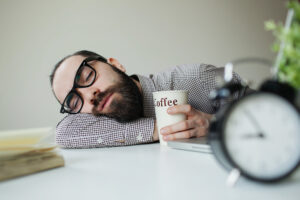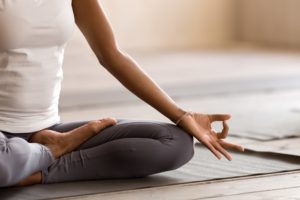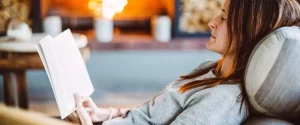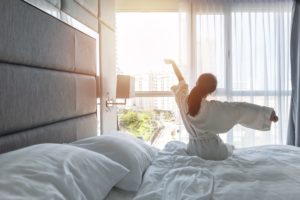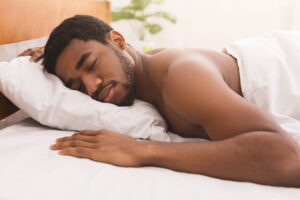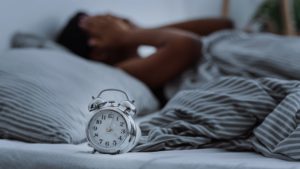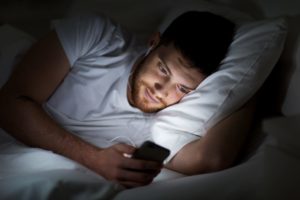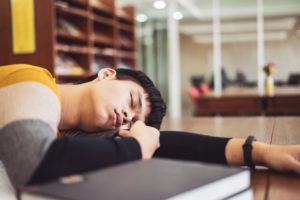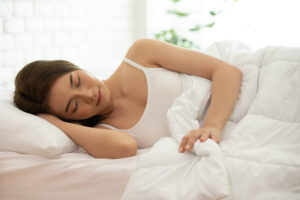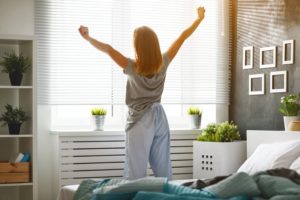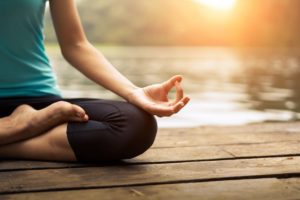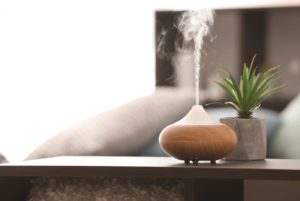Sleeping With Socks On
We’ve all been there: it’s the middle of winter, the bedroom is freezing, and your feet feel like ice. Maybe you throw on a pair of socks simply because it’s so cold, but the rest of the year you dislike the thought of sleeping with socks on.
Would you change your mind if sleeping with socks on regularly could help you regulate your body temperature, fall asleep faster, and even have a more fulfilling sex life? Learn about the surprising, research-backed benefits of sleeping with socks on.
Can Sleeping With Socks on Help Me Fall Asleep Faster?
The human body experiences heating and cooling rhythms throughout the day according to each individual’s own circadian rhythm . During waking hours, human body temperature sits at about 98.6 degrees Fahrenheit and can vary up to half a degree during the day. Lower body temperatures usually precede sleepiness, and evidence suggests that utilizing socks or other foot warming methods may lower your core body temperature and help you fall asleep faster .
Sleeping with socks on may not be for you if you have circulatory issues, swelling of the feet, or other issues that could potentially increase the likelihood of socks restricting blood flow to your legs and feet. As always, make sure to talk to your doctor about if sleeping with socks on is right for you.
What Temperature Will Help Me Sleep?
Research suggests that optimal room temperatures for sleeping range from 65 degrees to 70 degrees Fahrenheit. While studies show this range is most effective at getting you to sleep, some people prefer their bedroom cooler or warmer.
Gender differences also impact the optimal temperature for sleep. Women have a lower resting metabolic rate than men, which impacts their sensitivity towards chillier sleep environments . Men, on the other hand, are more likely to be resistant to warmer bedroom temperatures. If you sleep with a partner, try to find a temperature that is comfortable for both of you.
Why Wear Socks To Bed?
Setting the bedroom thermostat to a perfect temperature is only part of the equation for getting the best sleep possible. As our body increases melatonin production near the end of the day to prepare us for sleep, our core body temperature starts to drop . Wearing socks can help a process called distal vasodilation , which refers to an increase of blood to your hands and feet that reduces your core body temperature quicker.
Increasing blood flow by warming the feet, either through wearing socks to bed or other means, can help you fall asleep quicker . In one research study, participants who used socks or other foot warming methods not only fell asleep quicker but they reported staying asleep longer and experiencing an overall better quality of sleep.

Can Socks Help Sleep Disorders?
While wearing socks to bed might not help every sleep-wake disorder, evidence suggests that warming the feet before bed can reduce symptoms of insomnia . One research study demonstrated that warming feet for 20 minutes before bed reduces insomnia symptoms as well as fatigue. In a separate study, people suffering from insomnia experienced better sleep after warming their hands and feet .
However, research also suggests that elderly patients with insomnia do not experience any changes in their symptoms when increasing foot warming techniques. Age may play an important role in the efficacy of feet warming’s effect on sleep.
Other Advantages of Socks in Bed
In addition to falling asleep faster and staying asleep longer, you may enjoy more advantages when wearing socks to bed.
Prevention of Menopausal Hot Flashes
Menopausal hot flashes are due to an increase in core body temperature , which can happen during waking or sleeping. While there are other factors affecting hot flashes, such as hormone levels , we know that wearing socks to bed helps the body decrease core body temperature and therefore may help you avoid those midnight hot flashes.
Increased Likeliness of Orgasm
Believe it or not, in addition to improving sleep, wearing socks to bed could boost your sex life as well. One research study found that 80% of couples who wore socks achieved orgasm from sex, compared to the 50% previously studied without socks. While more research needs to be done, it’s clear that increasing blood flow and skin temperature helps people achieve orgasm.
Reduced Symptoms of Raynaud’s Syndrome
Raynaud’s syndrome involves a tight restriction of small arteries in the hands and feet, often due to exposure to cold. Wearing socks to bed can help stave off the cold, especially during winter, and might help prevent you from experiencing Raynaud’s syndrome symptoms.
Prevention of Cracked Feet
There’s no better time to pamper yourself than while you sleep! Apply a healing balm or lotion to your feet before bed, then cover with socks to help your feet stay moisturized. Make sure that you use a clean pair of socks each night and occasionally take breaks to prevent bacteria growth.
What Kind of Socks Are Best?
If you think sleeping with socks on might be for you, there are a few different types of socks you can try. Look for socks that are loose enough to allow proper blood circulation, and avoid compression socks. Also, opt for socks that do not retain moisture, which could encourage bacterial growth. For example, socks made of natural materials are often better than those made of synthetic materials, like polyester. Make sure you change your socks every night and wash your feet regularly.
Here are some of the best nighttime sock options to try:
- Cashmere or Merino Wool Socks allow for an adequate build up and expulsion of body heat due to the small size of their fibers. These socks are usually very soft and comfortable. However, they are often more expensive than other types of socks. Wool socks and sleepwear have been demonstrated to reduce sleep onset time and wakefulness during the night.
- Cotton Socks also allow for adequate heat build up and subsequent expulsion without trapping moisture and allowing bacteria to grow. Try finding cotton socks that are on the big side to ensure a loose and comfortable fit.
- Bed Socks are made specifically for sleeping in. They are loose, thick, and also prevent moisture and bacteria from growing. You can find them easily online.
How Does Wearing Socks To Bed Impact Sleep Hygiene?
Wearing socks to bed may help you fall asleep faster and stay asleep longer, so it could become an important part of your sleep hygiene routine.
Sleep hygiene refers to the habits, behaviors, and environmental factors present during our bedtime routine. Someone looking to improve their sleep hygiene habits might try freshening up their bedroom, incorporating relaxation techniques before bed, or adjusting their exercise routines. There are many ways to build good sleep hygiene. If sleeping with socks on helps you fall asleep quicker, then consider making it a part of your sleep hygiene.
Whether you chose to sleep with socks on or take a bath before bed, adding a habit that includes warming your feet to your nightly routine will likely help you fall asleep faster. If nothing else, incorporating a warming foot massage or nice bath before bed can help you shift gears from your busy day, so you’re more relaxed and ready for slumber.

Still have questions? Ask our community!
Join our Sleep Care Community — a trusted hub of sleep health professionals, product specialists, and people just like you. Whether you need expert sleep advice for your insomnia or you’re searching for the perfect mattress, we’ve got you covered. Get personalized guidance from the experts who know sleep best.
References
20 Sources
-
Webster, W. W., & Smarr, B. (2020). Using circadian rhythm patterns of continuous core body temperature to improve fertility and pregnancy planning. Journal of Circadian Rhythms, 18(1), online.
https://pubmed.ncbi.nlm.nih.gov/33024445/ -
Del Bene VE. Temperature. In: Walker HK, Hall WD, Hurst JW, editors. Clinical Methods: The History, Physical, and Laboratory Examinations. 3rd edition. Boston: Butterworths; 1990. Chapter 218.
https://www.ncbi.nlm.nih.gov/books/NBK331/ -
Raymann, R. J., Swaab, D. F., & Van Someren, E. J. (2007). Skin temperature and sleep-onset latency: Changes with age and insomnia. Physiology & Behavior, 90(2–3), 257–266.
https://pubmed.ncbi.nlm.nih.gov/17070562/ -
Harding, E. C., Franks, N. P., & Wisden, W. (2019). The temperature dependence of sleep. Frontiers in Neuroscience, 13, 336.
https://pubmed.ncbi.nlm.nih.gov/31105512/ -
Tsang, T., Mui, K., & Wong, L. (2021). Investigation of thermal comfort in sleeping environment and its association with sleep quality. Building and Environment, 187, 107406.
https://www.sciencedirect.com/science/article/pii/S0360132320307745 -
Harding, E. C., Franks, N. P., & Wisden, W. (2020). Sleep and thermoregulation. Current Opinion in Physiology, 15, 7–13.
https://pubmed.ncbi.nlm.nih.gov/32617439/ -
Barcat, L., Decima, P., Bodin, E., Delanaud, S., Stephan-Blanchard, E., Leke, A., Libert, J. P., Tourneux, P., & Bach, V. (2017). Distal skin vasodilation promotes rapid sleep onset in preterm neonates. Journal of Sleep Research, 26(5), 572–577.
https://pubmed.ncbi.nlm.nih.gov/28303621/ -
Obradovich, N., Migliorini, R., Mednick, S. C., & Fowler, J. H. (2017). Nighttime temperature and human sleep loss in a changing climate. Science Advances, 3(5), e1601555.
https://pubmed.ncbi.nlm.nih.gov/28560320/ -
Kräuchi, K., Cajochen, C., Werth, E., & Wirz-Justice, A. (2000). Functional link between distal vasodilation and sleep-onset latency? American Journal of Physiology-Regulatory, Integrative and Comparative Physiology, 278(3), R741–R748.
https://pubmed.ncbi.nlm.nih.gov/10712296/ -
Ko, Y., & Lee, J.-Y. (2018). Effects of feet warming using bed socks on sleep quality and thermoregulatory responses in a cool environment. Journal of Physiological Anthropology, 37(1), 13.
https://pubmed.ncbi.nlm.nih.gov/29699592/ -
Schwab, R. J. (2020, June). Insomnia and excessive daytime sleepiness (EDS). Merck Manual Consumer Version., Retrieved April 1, 2021, from
https://www.merckmanuals.com/home/brain,-spinal-cord,-and-nerve-disorders/sleep-disorders/insomnia-and-excessive-daytime-sleepiness-eds -
Yang, H. L., Chen, X. P., Lee, K. C., Fang, F. F., & Chao, Y. F. (2010). The effects of warm-water footbath on relieving fatigue and insomnia of the gynecologic cancer patients on chemotherapy. Cancer Nursing, 33(6), 454–460.
https://pubmed.ncbi.nlm.nih.gov/20562619/ -
van den Heuvel, C., Ferguson, S., & Dawson, D. (2006). Attenuated thermoregulatory response to mild thermal challenge in subjects with sleep-onset insomnia. Sleep, 29(9), 1174–1180.
https://pubmed.ncbi.nlm.nih.gov/17040004/ -
Liao, W. C., Chiu, M. J., & Landis, C. A. (2008). A warm footbath before bedtime and sleep in older Taiwanese with sleep disturbance. Research in Nursing & Health, 31(5), 514–528.
https://pubmed.ncbi.nlm.nih.gov/18459154/ -
Freedman, R. R., & Woodward, S. (1996). Core body temperature during menopausal hot flushes. Fertility and Sterility, 65(6), 1141–1144.
https://pubmed.ncbi.nlm.nih.gov/8641487/ -
Freedman, R. R. (2014). Menopausal hot flashes: Mechanisms, endocrinology, treatment. The Journal of Steroid Biochemistry and Molecular Biology, 142, 115–120.
https://pubmed.ncbi.nlm.nih.gov/24012626/ -
Roberts, M. (2005, June 20). BBC NEWS | Health | Scan spots women faking orgasms. BBC News. Accessed on April 1st, 2021, from, Accessed on April 1st, 2021, from
http://news.bbc.co.uk/2/hi/health/4111360.stm -
Alinsod, R. M. (2016). Transcutaneous temperature controlled radiofrequency for orgasmic dysfunction. Lasers in Surgery and Medicine, 48(7), 641–645.
https://pubmed.ncbi.nlm.nih.gov/27197701/ -
Teo, K. K. (2019, July). Raynaud syndrome. Merck Manuals Consumer Version., Retrieved April 1, 2021, from
https://www.merckmanuals.com/home/heart-and-blood-vessel-disorders/peripheral-arterial-disease/raynaud-syndrome -
Chow, C. M., Shin, M., Mahar, T. J., Halaki, M., & Ireland, A. (2019). The impact of sleepwear fiber type on sleep quality under warm ambient conditions. Nature and Science of Sleep, 11, 167–178.
https://pubmed.ncbi.nlm.nih.gov/31692485/



